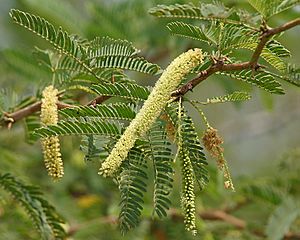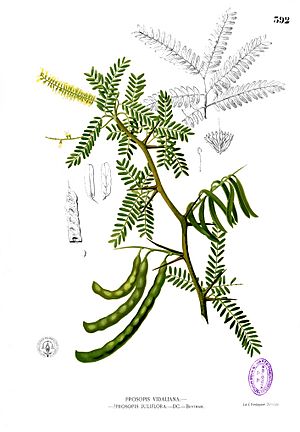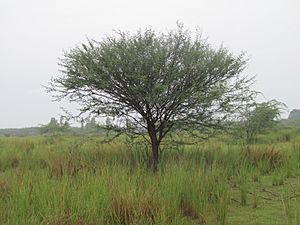Prosopis juliflora facts for kids
Quick facts for kids Prosopis juliflora |
|
|---|---|
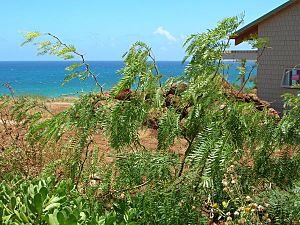 |
|
| Young tree | |
| Scientific classification | |
| Genus: |
Prosopis
|
| Species: |
juliflora
|
| Synonyms | |
|
Many, see text |
|
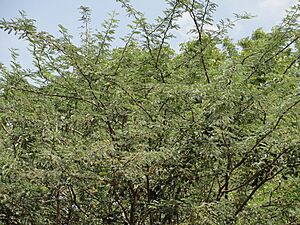
Prosopis juliflora is a type of mesquite tree or shrub. It belongs to the Fabaceae family, which includes many plants that produce pods. This plant is originally from Mexico, South America, and the Caribbean. However, it has spread to many other parts of the world, including Africa, Asia, and Australia. In these new places, it often grows out of control and is considered an invasive weed. This means it can cause problems for local plants and animals. For example, in some dry areas, it can even help mosquitoes spread malaria because it provides them with sugar when other plants are scarce.
Contents
What Prosopis juliflora Looks Like
This plant can grow quite tall, up to about 12 meters (40 feet). Its trunk can become very wide, sometimes over 1 meter (4 feet) across. The leaves are light green and fall off during certain seasons (deciduous). Each leaf has many small leaflets, usually 12 to 20 of them.
Soon after new leaves grow, the plant produces flowers. These flowers are yellowish-green and grow in long, cylinder-shaped spikes, about 5 to 10 centimeters (2 to 4 inches) long. You'll often see these spikes in groups of 2 to 5 at the ends of branches.
After flowering, the plant produces pods that are 20 to 30 centimeters (8 to 12 inches) long. Each pod holds 10 to 30 seeds. A single mature plant can make hundreds of thousands of seeds! These seeds can stay alive and able to grow for up to 10 years. The plant only grows from seeds; it doesn't spread through its roots or other parts. Animals like cattle eat the sweet pods, and then they spread the seeds in their droppings.
One amazing thing about Prosopis juliflora is how deep its roots can go. In 1960, roots were found 53 meters (174 feet) deep in a mine in Tucson, Arizona. This makes them some of the deepest known roots in the world! This helps the plant find water even in very dry places.
This tree was brought to Sri Lanka in the 1800s. There, it is known by names like vanni-andara or katu andara. It has thorns that grow in pairs on its branches. Some individual plants might have fewer thorns than others.
In places like Ecuador and Peru, Prosopis juliflora can sometimes mix with a similar plant called Prosopis pallida. When they mix, they create hybrid plants, which can make it hard to tell them apart.
Names for Prosopis juliflora
Prosopis juliflora has many different names around the world, but there isn't one common English name for it. People often just call it "mesquite," which is a name used for several different Prosopis species.
In Spanish, it's called bayahonda blanca. In French, it's bayarone Français, and in Creole, it's bayawonn. Other names include algarrobe, cambrón, cashaw, épinard, mostrenco, or mathenge. Many of these names are used because this plant is the most common Prosopis species in those areas, so people just call it "the" bayahonde or "the" algarrobe.
Where the Names Come From
In the Indian subcontinent, where this tree is often used for firewood and to make fences, its names often show that it was brought from somewhere else. For example, in Hindi, it's called angaraji babul or vilayati kikar. The words angaraji and vilayati mean "introduced by Europeans." Kabuli kikar means "Kabul acacia." These names compare it to native trees like Vachellia nilotica (babul) and Prosopis cineraria (khejra).
In the Gujarati language, it's called gando baval, which means "the mad tree." In Tamil Nadu, it's known as seemai karuvel, meaning "foreign" + "Vachellia nilotica." Another Tamil name, velikathan, means "fence protector" because its thorns are good for making barriers. In Telugu, it has names like mulla tumma or kampa chettu. In Somali, it's called 'Garan-waa', which means 'the unknown'. In Kenya, it's known as Mathenge.
Why Prosopis juliflora Can Be a Problem
Prosopis juliflora has become an invasive weed in many countries where it was not originally found. This means it spreads quickly and can harm the local environment. It's considered a serious problem in places like Ethiopia, Hawaii, Sri Lanka, Jamaica, Kenya, India, Sudan, and South Africa. It's very difficult and expensive to remove because it can grow back from its deep roots.
In Australia, this mesquite has taken over more than 800,000 hectares (about 2 million acres) of farmland. It causes big problems for the economy and the environment. Its thorns and many low branches create thick, thorny bushes that make it impossible for cattle to reach water or grazing areas. It also uses up scarce water that native plants and animals need. If livestock eat too many of its pods, they can get sick from poisons in the plant. The plant also causes land erosion by replacing native grasslands and provides hiding places for wild animals like pigs and cats.
In the Afar Region of Ethiopia, Prosopis juliflora was brought in during the late 1970s and early 1980s. It grows so fast and thick that it creates a monoculture (only one type of plant). This takes away water and sunlight from native plants and leaves no food for local animals and cattle. Local people call it the "Devil Tree" and want it removed.
In Sri Lanka, Prosopis juliflora was planted in the 1950s to provide shade and stop soil erosion. But it quickly spread into grasslands, causing problems similar to those in Australia and Ethiopia.
In the Indian state of Tamil Nadu, Prosopis juliflora has become a major invasive species. The British first brought it in 1877 to plant in dry areas. In the 1960s, the government even encouraged planting it to help with firewood shortages and to make fences. However, by 2017, the Madras High Court ordered the state government to get rid of the plant. In 2022, the court pushed the government to create a plan to remove it, and a policy was finally put in place on July 13, 2022.
In Europe, Prosopis juliflora was added to a list of "Invasive Alien Species of Union concern" in 2019. This means it cannot be brought into, grown, sold, or planted anywhere in the European Union.
Uses of Prosopis juliflora
Even though it can be an invasive plant, Prosopis juliflora has some uses. Its sweet pods are safe to eat and are full of nutrients. For a long time, they have been a traditional food source for native people in Peru, Chile, and California. People used to chew the pods during long trips to help with thirst. The pods can be eaten fresh, boiled, or dried and ground into flour to make bread. They can also be stored underground or fermented to make a slightly alcoholic drink. Before Europeans arrived, the Guaraní people of South America even made a type of beer from mashed pods and wild honey.
Besides food, the plant is also used for animal feed, wood, and for managing the environment in some places. Its wood contains a special substance called (-)-mesquitol.
In the Macará Canton of Ecuador, Prosopis juliflora is one of the most common trees harvested from dry forests for various forest products.
See also
 In Spanish: Prosopis juliflora para niños
In Spanish: Prosopis juliflora para niños



